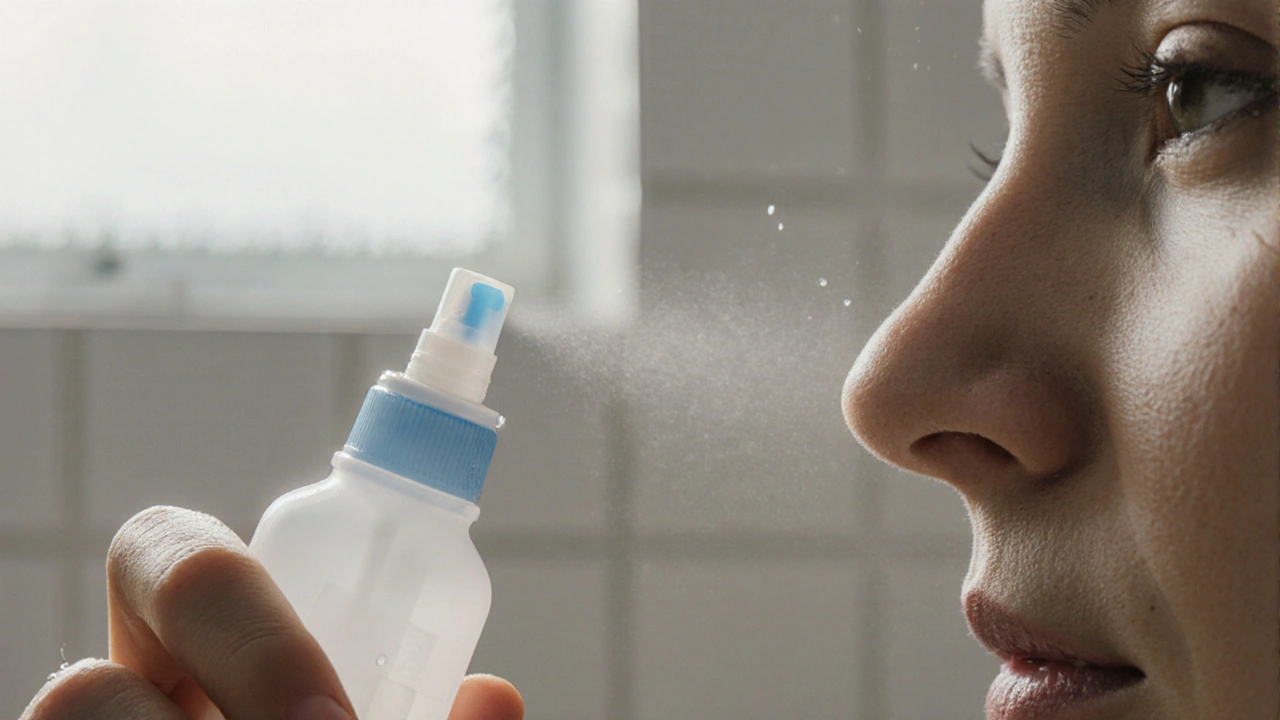Nasonex vs Alternatives Comparison Tool
Recommended Nasal Spray:
| Product | Active Ingredient | Prescription? | Onset Time | Duration | Monthly Cost (AU$) | Side Effects |
|---|---|---|---|---|---|---|
| Nasonex | Mometasone furoate monohydrate | Prescription | 24-48 hrs | Up to 24 hrs | ≈ 30-35 | Nasal dryness, mild headache |
| Flonase (generic Fluticasone) | Fluticasone propionate | OTC | 12-24 hrs | 12-24 hrs | ≈ 25-30 | Throat irritation, epistaxis (rare) |
| Rhinocort | Budesonide | OTC (Australia) | 24-48 hrs | 24 hrs | ≈ 20-25 | Nasal burning, cough |
| Beconase | Beclomethasone dipropionate | Prescription (some OTC in US) | 24-72 hrs | Up to 48 hrs | ≈ 28-32 | Nasal dryness, taste alteration |
| Astelin | Azelastine hydrochloride | Prescription (antihistamine spray) | Immediate (within minutes) | 4-6 hrs | ≈ 35-40 | Bad taste, drowsiness (rare) |
| Saline nasal spray | None (isotonic salt solution) | OTC | Immediate (mechanical) | Transient | ≈ 5-10 | None |
Ever wonder why a single spray sometimes feels like it does nothing, while another brand clears your sinuses in minutes? The key lies in the active ingredients, dosing, and how your body reacts. Nasonex is a prescription‑only intranasal corticosteroid that contains mometasone furoate monohydrate. It’s designed to shrink inflamed nasal tissue, reduce mucus, and relieve the sneezing, itching, and congestion that come with allergic rhinitis. If you’re weighing Nasonex against other options, you’ll want to look at effectiveness, onset speed, side‑effect profile, cost, and whether you need a doctor’s script.
Why the active ingredient matters
All intranasal steroids share a basic goal - calm the immune response in the nasal lining. But the molecule’s shape, potency, and solubility change how quickly it works and how long it stays active. Mometasone furoate is a high‑potency glucocorticoid with a long residence time on the mucosa, meaning you often need only one or two sprays per day. In contrast, Fluticasone propionate (the active ingredient in Flonase and similar OTC products) is slightly less potent but available without a prescription, making it a popular first‑line choice.
Key decision criteria
- Prescription vs OTC: Do you want a drug you can buy off the shelf, or are you comfortable visiting a GP for a script?
- Onset of relief: Some users notice improvement within hours; others need a week of consistent use.
- Side‑effect tolerance: Nasal dryness, irritation, or rare systemic effects can influence your pick.
- Cost per month (AU$): Pricing varies widely between brand name, generic, and saline options.
- Specific allergy profile: Certain ingredients may work better for pollen vs indoor allergens.
Head‑to‑head comparison
| Product | Active ingredient | Prescription? | Typical onset | Duration of action | Average monthly price (AU$) | Common side effects |
|---|---|---|---|---|---|---|
| Nasonex | Mometasone furoate monohydrate | Prescription | 24‑48hrs | Up to 24hrs | ≈30‑35 | Nasal dryness, mild headache |
| Flonase (generic Fluticasone) | Fluticasone propionate | OTC | 12‑24hrs | 12‑24hrs | ≈25‑30 | Throat irritation, epistaxis (rare) |
| Rhinocort | Budesonide | OTC (Australia) | 24‑48hrs | 24hrs | ≈20‑25 | Nasal burning, cough |
| Beconase | Beclomethasone dipropionate | Prescription (some OTC in US) | 24‑72hrs | Up to 48hrs | ≈28‑32 | Nasal dryness, taste alteration |
| Astelin | Azelastine hydrochloride | Prescription (antihistamine spray) | Immediate (within minutes) | 4‑6hrs | ≈35‑40 | Bad taste, drowsiness (rare) |
| Saline nasal spray | None (isotonic salt solution) | OTC | Immediate (mechanical) | Transient | ≈5‑10 | None |

Best‑fit scenarios
- Nasonex: Ideal if you need a once‑daily high‑potency steroid and have a prescription on hand. Works well for chronic allergic rhinitis and nasal polyps.
- Flonase/Fluticasone: Great for occasional users who prefer OTC convenience and are comfortable with a slightly slower onset.
- Rhinocort (Budesonide): A solid mid‑potency choice for people who experience mild dryness with fluticasone.
- Beconase: Useful when a slightly longer duration (up to 48hrs) fits a busy schedule, provided you can tolerate a mild after‑taste.
- Astelin (Azelastine): The go‑to when rapid relief from sudden allergy flare‑ups is needed, but you don’t mind a non‑steroid option.
- Saline spray: Perfect as a daily hygiene routine or to prep the nose before using a steroid-no side effects, virtually free.
Potential pitfalls and how to avoid them
- Over‑use: Spraying more than the recommended dose can increase risk of nosebleeds and, rarely, systemic steroid effects. Stick to the label-usually 1‑2 sprays per nostril daily.
- Incorrect technique: Tilting your head too far forward can cause the spray to run down the throat, reducing efficacy. Aim the nozzle slightly outward, breathe in gently, and avoid sniffing hard after the spray.
- Dryness & irritation: Pair a steroid spray with a saline rinse once a day to keep the mucosa moist.
- Allergic reactions to preservatives: Some formulations contain benzalkonium chloride. If you notice burning or itching, switch to a preservative‑free version or a saline alternative.
- Drug interactions: High‑dose intranasal steroids can add to systemic steroid load if you’re already on oral prednisone. Discuss with your GP before combining.
Quick TL;DR
- Nasonex offers the most potent once‑daily relief but requires a prescription.
- Fluticasone (Flonase) is a convenient OTC option with a slightly slower onset.
- Budesonide (Rhinocort) balances potency and cost, good for mild‑moderate symptoms.
- Beclomethasone (Beconase) provides longer coverage at a modest price.
- Azelastine (Astelin) works fastest for acute flare‑ups but is not a steroid.
- Saline spray is free of side effects and useful as a complementary rinse.
Frequently Asked Questions
Can I use Nasonex without a prescription if I’ve used it before?
In Australia, Nasonex remains a prescription‑only medication. Even if you’ve used it abroad OTC, you’ll need a doctor’s script to obtain it locally.
How long does it take for Nasonex to start working?
Most users notice a reduction in congestion within 24‑48hours, but optimal relief for chronic rhinitis can take up to 2weeks of consistent daily use.
Is it safe to combine Nasonex with an oral antihistamine?
Yes, the combination is common and generally well‑tolerated. The steroid tackles inflammation, while the antihistamine blocks histamine release, giving broader symptom control.
What’s the main advantage of an antihistamine spray like Astelin over a steroid spray?
Azelastine works within minutes, making it ideal for sudden allergy spikes. It doesn’t carry the (albeit low) systemic steroid risk that long‑term steroid use may pose.
Can children use Nasonex?
Yes, it’s approved for children aged 2years and older, but the dose is lower (one spray per nostril once daily). Always check with a pediatrician first.
Why does my nose feel dry after using a nasal spray?
Steroid sprays can reduce mucus production, leading to dryness. Counteract this by using a saline rinse or a humidifier, especially in winter.
Are there generic versions of Nasonex?
In Australia, a generic mometasone furoate spray is available under the name ‘Mometasone Nasal Spray’. It carries the same active ingredient and dosing strength as Nasonex.

Next steps for choosing the right spray
1. **Identify your symptom pattern** - chronic year‑round congestion points to a daily steroid; occasional spikes may be handled with an antihistamine spray.
2. **Check prescription requirements** - if you prefer over‑the‑counter, Flonase or Rhinocort are solid picks.
3. **Factor in cost** - compare your private health cover rebates; many plans cover Nasonex for a lower co‑pay.
4. **Test technique** - a proper spray can be the difference between “no change” and “clear breathing”. If unsure, ask your pharmacist for a quick demo.
5. **Monitor side effects** - give any new spray a 2‑week trial; if nosebleeds or severe dryness persist, switch to a milder alternative or add a saline rinse.
By lining up these steps with the comparison table above, you’ll land on a nasal spray that actually clears the congestion instead of just adding to the hassle.


Samantha Kolkowski
October 3, 2025 AT 23:06I was scrolling through the comparison and thought the table was super handy. The way they break down onset time vs cost really helped me pick something for my seasonal allergies. I kinda wish they'd mention the smell of each spray, cause that matters to me. Overall, good info but a couple of typos slipped through. Still, thanks for the thorough rundown.
Nick Ham
October 15, 2025 AT 21:13The pharmacokinetic profile delineated for mometasone versus fluticasone reflects suboptimal receptor affinity, rendering Nasonex a subpar therapeutic index.
Ben Muncie
October 27, 2025 AT 19:20While everyone praises Nasonex’s potency, the overreliance on steroids fuels unnecessary systemic exposure, which I consider irresponsible.
kevin tarp
November 8, 2025 AT 17:28From a clinical standpoint, the data on once‑daily dosing aligns with guideline recommendations, making Nasonex a viable first‑line option for persistent rhinitis.
ravi kumar
November 20, 2025 AT 15:35Our country’s healthcare system should prioritize affordable OTC options like Flonase instead of pushing pricey prescriptions such as Nasonex, which only benefits big pharma.
Barry Singleton
December 2, 2025 AT 13:42Sure, the cost difference is marginal, but the marketing hype around mometasone feels manufactured.